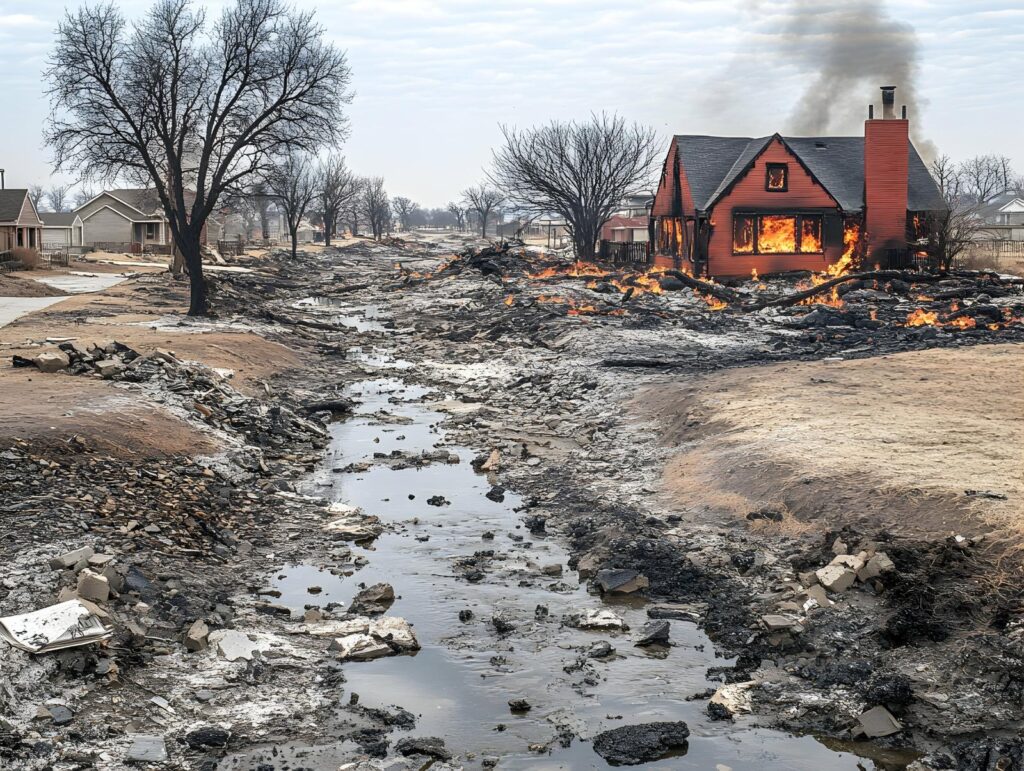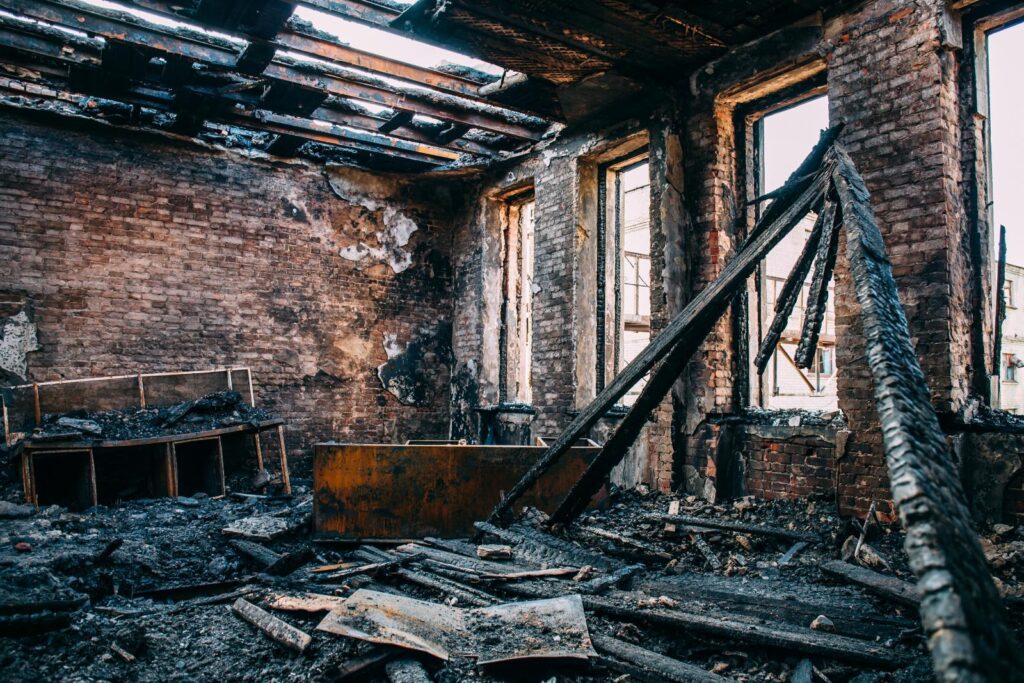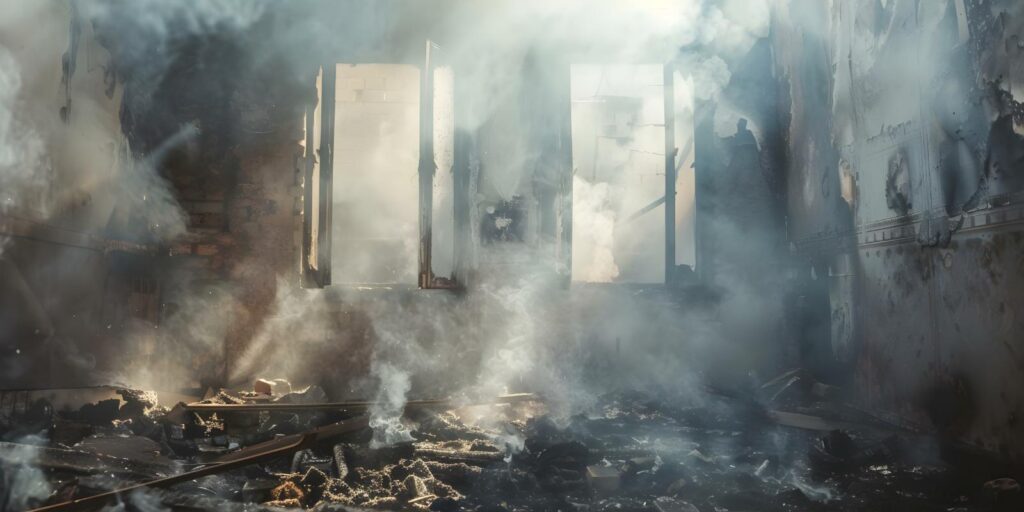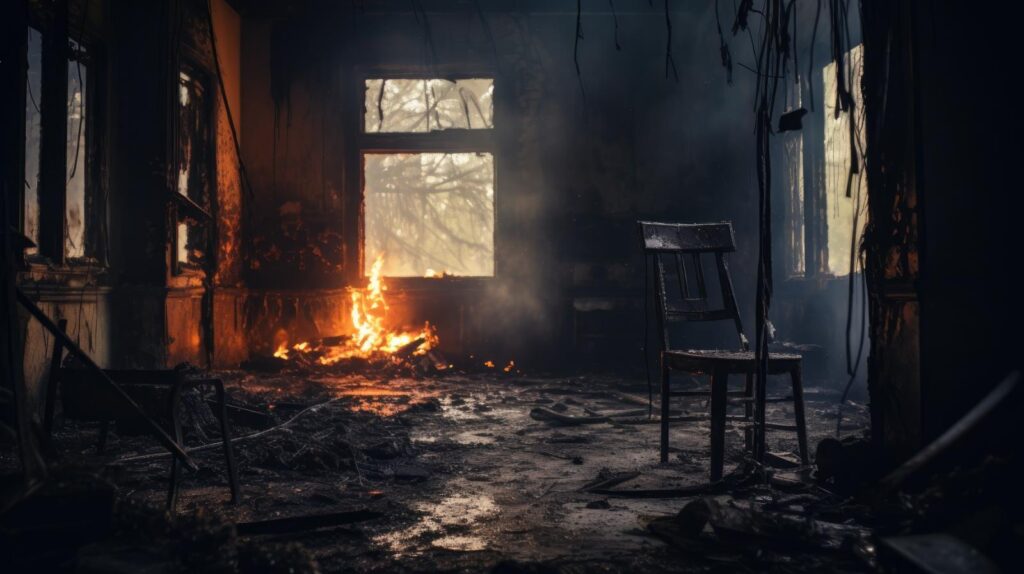
Contents
Fire can be both devastating and an opportunity for renewal. As you confront the aftermath, knowing where to start can feel overwhelming. It’s crucial to prioritize safety and methodically assess the damage cleanup before jumping into cleanup. You’ll need the right supplies and techniques to tackle debris and persistent odors effectively. But before you dive in, there are specific steps you must follow to ensure you’re not just cleaning, but restoring your space properly. What are those steps, and how can you avoid common pitfalls?
Key Takeaways
- Document the damage thoroughly with photographs and lists, categorizing items by severity for insurance claims.
- Prioritize safety by wearing protective gear and assessing structural integrity before entering affected areas.
- Gather necessary cleanup supplies, including gloves, masks, and cleaning agents, to effectively manage debris and soot removal.
- Address water damage promptly with extraction methods and use dehumidifiers to prevent mold growth in affected areas.
- Ventilate spaces to remove smoke odors, using natural remedies or commercial products, and consider professional help for extensive damage.
Assessing the Damage
When you’re faced with the aftermath of a fire, your first step should be assessing the damage to your property. This damage evaluation is crucial not only for your peace of mind but also for moving forward with insurance claims.
Start by carefully documenting the extent of the damage. Take clear photographs of affected areas, both inside and outside your home. This visual evidence will be invaluable when you communicate with your insurance provider.
Next, make a list of damaged items, categorizing them by severity. Note structural damage, such as charred beams, along with damages to personal belongings. This organized approach will help streamline the claims process, ensuring you don’t overlook anything important.
If it’s safe to do so, gently inspect the affected areas for hidden damage, like smoke stains or water damage from firefighting efforts.
It’s wise to involve professionals early on. They can offer more thorough evaluations that may uncover issues you might miss, which is especially important for your safety and the integrity of your home.
As you gather evidence and information, stay in close contact with your insurance agent. They can guide you on how to file your claims efficiently.
Safety Precautions First
Before you start any fire damage cleanup, it’s crucial to prioritize your safety.
Make sure you’re wearing appropriate protective gear, such as gloves, masks, and goggles, to shield yourself from harmful debris and smoke.
Additionally, assess the structural integrity of the building to ensure it’s safe to enter and work in the affected areas.
Wear Protective Gear
To ensure your safety during fire damage cleanup, wearing protective gear is essential. Start by donning protective clothing that covers as much of your skin as possible. This includes long-sleeved shirts, pants, and sturdy boots. Fire-damaged environments can harbor harmful debris, sharp objects, and toxic substances, making full coverage vital.
Next, don’t forget about safety goggles. These are crucial for protecting your eyes from soot, dust, and potential splashes from cleaning solutions. Your vision is invaluable, and safeguarding it should be a top priority during cleanup activities.
Additionally, consider wearing a mask or respirator to filter out airborne particles and harmful fumes. Smoke can linger long after a fire is extinguished, and inhaling these pollutants can lead to serious health issues.
Lastly, gloves are a must. They not only protect your hands from cuts and abrasions but also from hazardous materials you may encounter.
Assess Structural Integrity
Start by thoroughly inspecting the structure of the building for any signs of damage, as this is crucial for ensuring your safety during fire damage cleanup. A proper structural evaluation is essential, as even seemingly minor damage can compromise the integrity of the building.
Begin your assessment at the roof and work your way down, looking for sagging, cracks, or warping in the materials.
During your damage assessment, consider these key points:
- Check Load-Bearing Walls****: Ensure they’re intact; damage here can lead to serious issues.
- Examine Support Beams****: Look for signs of charring or weakness that could jeopardize stability.
- Assess Floors and Ceilings**: Pay attention to any unevenness or drooping**, which could indicate underlying problems.
Always remember to prioritize your safety. If you’re unsure about any aspect of the structural integrity, consult a professional.
They can provide expert guidance and help you navigate the complexities of fire damage cleanup. Trusting your instincts and assessing the situation carefully won’t only keep you safe but also foster a sense of community as you work towards recovery.
Gathering Necessary Supplies
When tackling fire damage cleanup, gathering the right supplies is crucial for an efficient and effective process. You’ll want to prioritize both fire safety and the necessary cleanup equipment to ensure a thorough job without compromising your well-being.
Start by assembling personal protective gear. This includes gloves, masks, goggles, and sturdy boots. These items are essential to protect you from hazardous materials and debris.
Next, gather your cleanup equipment. A heavy-duty trash bag or dumpster is vital for collecting debris and charred materials. You’ll also need a shovel, brooms, and dustpans for efficient removal.
Consider investing in a high-efficiency particulate air (HEPA) vacuum, as it can capture fine soot particles that may linger in the air and on surfaces.
In addition, have cleaning solutions ready. Look for products specifically designed for soot and smoke damage. These can significantly aid in restoring surfaces to their original condition.
You’ll also want to have a bucket, sponges, and rags for washing walls and other surfaces.
Lastly, don’t forget about fire safety equipment. A fire extinguisher should always be within reach, ensuring you can respond quickly to any flare-ups during the cleanup process.
Removing Debris and Ash
After ensuring you’ve donned your protective gear, begin the process of removing debris and ash with a systematic approach.
Start by assessing the area to identify the most affected zones. This will help you prioritize your efforts and work more efficiently. Remember, debris removal isn’t just about cleaning up; it’s also about ensuring safety and preventing further damage.
Gather your tools—shovels, brooms, dustpans, and heavy-duty trash bags are essential. As you start, carefully pick up larger pieces of debris first, such as charred furniture or structural materials. Place these items in sturdy bags or containers for safe transport.
When it comes to ash disposal, make sure you’re using proper techniques to avoid causing a dust cloud or inhaling harmful particles.
Here are three key points to keep in mind during your cleanup:
- Work in sections: Focus on one area at a time to stay organized and effective.
- Use proper disposal methods: Check local regulations for ash disposal, as it can be hazardous.
- Stay mindful of hazards: Watch out for sharp objects, unstable surfaces, or smoldering materials.
Cleaning Surfaces Thoroughly
Thoroughly cleaning surfaces is crucial for restoring safety and hygiene after fire damage. Smoke and soot can linger on walls, floors, and furniture, posing health risks and leaving unsightly stains. To effectively tackle this, you’ll want to employ the right surface cleaning techniques and effective cleaning solutions.
Start by gathering your supplies, including gloves, masks, sponges, and cleaning agents specifically designed for fire damage cleanup. Here’s a helpful guide to get you started:
| Surface Type | Recommended Cleaning Solution |
|---|---|
| Walls and Ceilings | Vinegar and water solution |
| Hard Surfaces | Heavy-duty degreaser |
| Upholstery | Specialized fabric cleaner |
Begin with walls and ceilings, using a vinegar and water solution. This can neutralize odors while lifting smoke residue. For hard surfaces like countertops and tables, a heavy-duty degreaser is effective for breaking down stubborn soot. Always test a small area first to ensure there’s no discoloration.
When dealing with upholstery, opt for a specialized fabric cleaner. Follow the product instructions for the best results. It’s important to allow surfaces to dry completely after cleaning to prevent mold growth.
Addressing Water Damage
Significant water damage can often accompany fire incidents, especially if firefighters used hoses to extinguish the blaze.
After a fire, it’s crucial to address this water damage promptly to prevent further issues such as mold growth or structural damage. Here’s a methodical approach to tackle the situation effectively.
First, you should prioritize water extraction. Begin by removing any standing water using pumps or wet vacs. This step is vital to minimize water seepage into materials that can retain moisture.
Next, focus on moisture control. You’ll need to dry out affected areas as quickly as possible. Use fans, dehumidifiers, and natural ventilation to promote airflow and reduce humidity levels.
Consider these actions when dealing with water damage:
- Inspect: Thoroughly check walls, floors, and ceilings for signs of water damage.
- Remove: Take out any soaked materials, such as carpets or drywall, to prevent mold.
- Monitor: Keep an eye on moisture levels, ensuring they remain low to avoid future complications.
Smoke Odor Removal Techniques
Once you’ve addressed the water damage, it’s time to tackle the lingering smoke odors that can permeate your space following a fire.
These odors can be persistent and unpleasant, but with the right approach, you can effectively eliminate them.
Start by ventilating the area. Open windows and doors to allow fresh air to circulate and help disperse the smoke smell. You can also use fans to speed up the process.
Next, consider using natural remedies. Baking soda is a powerful odor absorber; sprinkle it on carpets, upholstery, and other surfaces, leave it overnight, and then vacuum it up. Activated charcoal is another excellent choice for neutralizing odors—place bowls of it around the affected areas to absorb the smell.
For more stubborn odors, you might need to turn to commercial products. Look for specialized smoke odor eliminators designed for fire damage recovery. Always follow the instructions carefully, as these products vary in application.
An ozone generator can also be effective; it generates ozone molecules that attach to odor particles, neutralizing them. However, be sure to follow safety precautions, as high ozone levels can be harmful.
Lastly, don’t overlook textiles. Wash curtains, bedding, and any clothing affected by smoke. If necessary, consider professional cleaning services for large items or delicate fabrics.
With these methods, you can create a more inviting atmosphere, free from the reminders of the fire.
Mold Prevention Strategies
After addressing smoke odors and water damage, it’s crucial to implement effective mold prevention strategies to safeguard your home. Mold thrives in damp environments, so controlling moisture is your first line of defense.
Start by employing moisture control methods, ensuring that your home remains dry and well-ventilated. Fix any leaks in pipes or roofs promptly, and consider using dehumidifiers in areas prone to high humidity, like basements and bathrooms.
Next, familiarize yourself with mold identification techniques. Regularly inspect your home for signs of mold growth, especially in hidden areas such as behind walls, under carpets, and in attics. By catching mold early, you’re less likely to face a larger infestation down the line.
Here are some key strategies to keep mold at bay:
- Maintain Indoor Humidity****: Keep indoor humidity levels below 50% using dehumidifiers and air conditioners.
- Improve Air Circulation: Open windows and use exhaust fans during cooking and bathing to promote airflow.
- Seal and Insulate: Properly insulate your home, especially around pipes, windows, and doors, to reduce condensation.
Salvaging Personal Belongings
When it comes to salvaging personal belongings after fire damage, acting quickly can make a significant difference in recovering your possessions.
Begin by assessing the damage to determine which items are salvageable. Focus on items with high sentimental value, as these often can’t be replaced. Document everything you find, taking photographs for insurance purposes and to keep a record of your personal item recovery efforts.
Next, prioritize the recovery based on the condition of each item. Start with the most crucial belongings, such as family heirlooms, photographs, and important documents.
For items that have been exposed to smoke or water, gently clean them using appropriate methods. For instance, photographs can often be rinsed in cool water, while furniture may need specialized cleaning solutions.
If you’re dealing with clothing, dry-cleaning services can often restore them to their pre-loss condition. Be mindful of what you touch, as soot and ash can further damage delicate items. If you’re unsure how to clean specific belongings, research best practices or consult a professional.
Once you’ve salvaged what you can, store the recovered items in a safe, dry location. This will protect them from further damage while you assess the next steps.
When to Call Professionals
Determining the right time to call professionals for fire damage cleanup can save you time and prevent further complications. Knowing when to hire experts is crucial, especially when you notice signs of urgency. You might think you can handle everything yourself, but some situations require specialized knowledge and equipment.
Here are a few indicators that it’s time to seek professional help:
- Extensive Damage: If the fire has caused significant structural damage or widespread smoke and soot, you’ll need trained professionals to assess and manage the situation properly.
- Health Hazards: If you detect lingering odors, hazardous materials, or toxic mold growth, it’s essential to call in experts who can safely address these risks.
- Insurance Requirements: Sometimes, your insurance policy will require you to hire certified professionals for cleanup and restoration. Not adhering to these requirements can jeopardize your claims.
You might feel overwhelmed, but reaching out for help isn’t a sign of weakness; it’s a smart decision.
Professionals have the training, tools, and experience to restore your space efficiently and effectively. They can also guide you through the claims process, ensuring you get the support you need.
Don’t wait too long to act—delaying may lead to more extensive damage and higher costs down the line. Trust your instincts and remember that you’re not alone; help is just a call away.
Final Thoughts
In conclusion, navigating fire damage cleanup can be daunting, but taking methodical steps can make a significant difference. Did you know that nearly 50% of fire-related injuries occur during cleanup efforts? This statistic underscores the importance of prioritizing safety and being well-prepared. By following the tips outlined in this guide, you can effectively restore your space while minimizing risks. Remember, when in doubt, don’t hesitate to call professionals for assistance to ensure a thorough and safe recovery.



